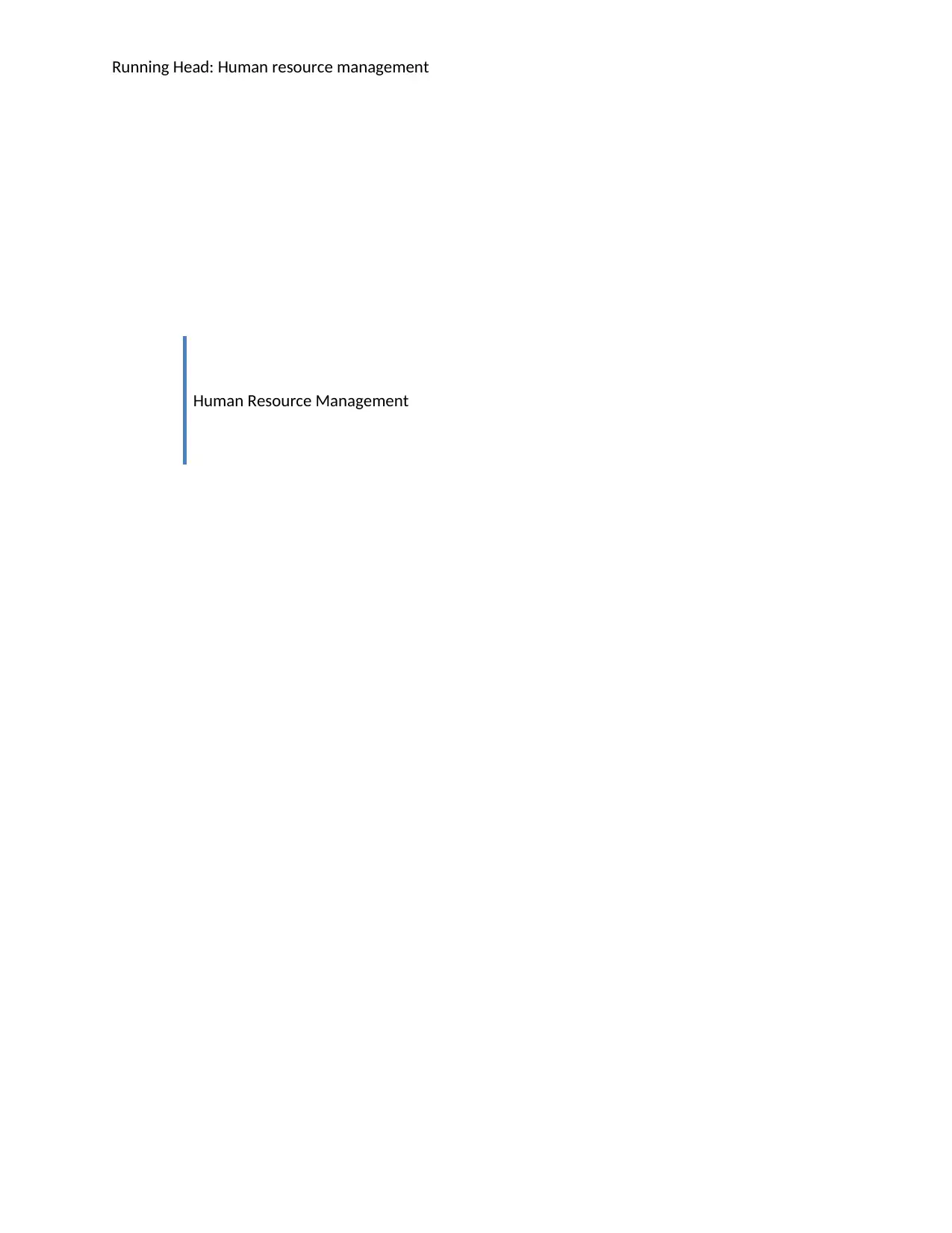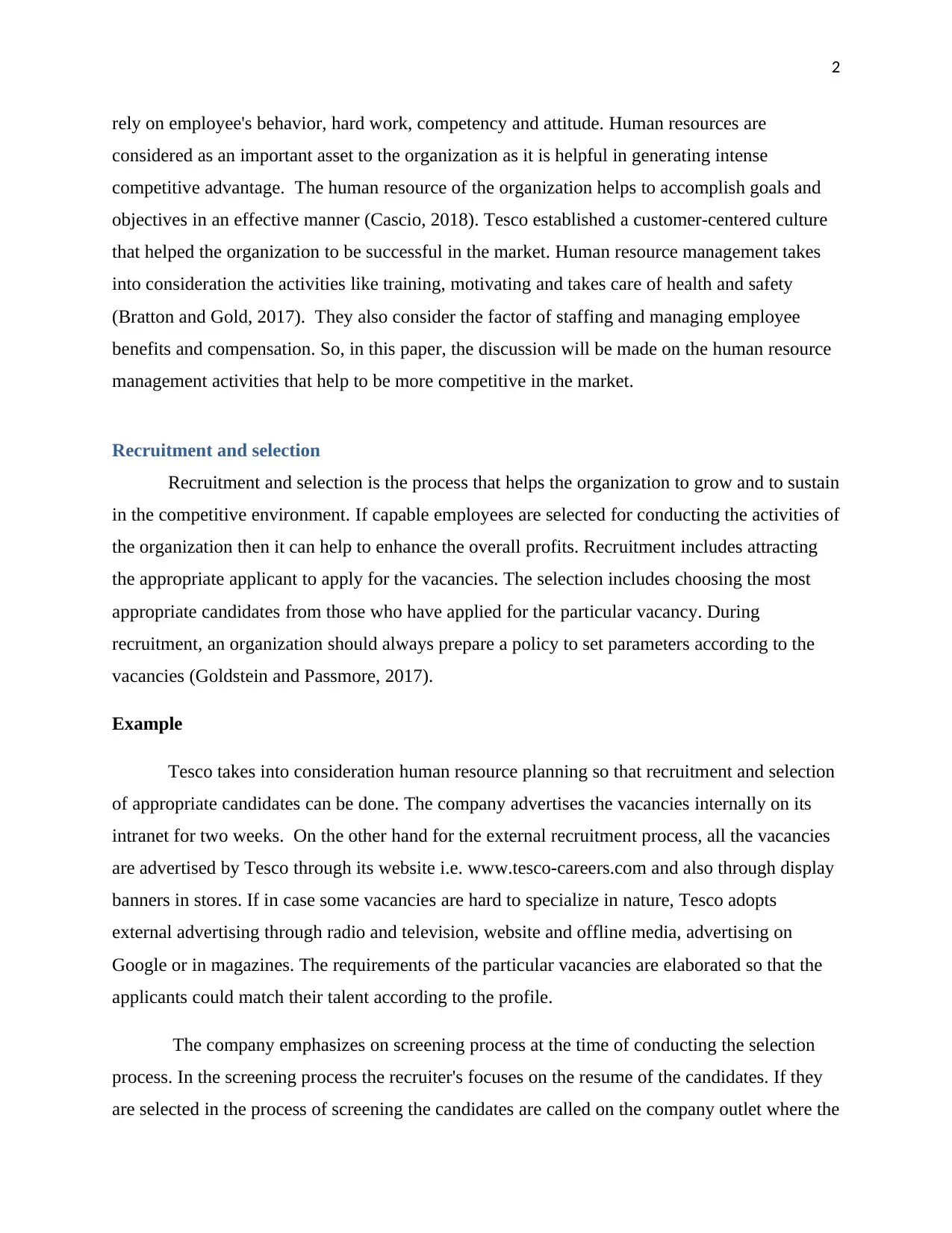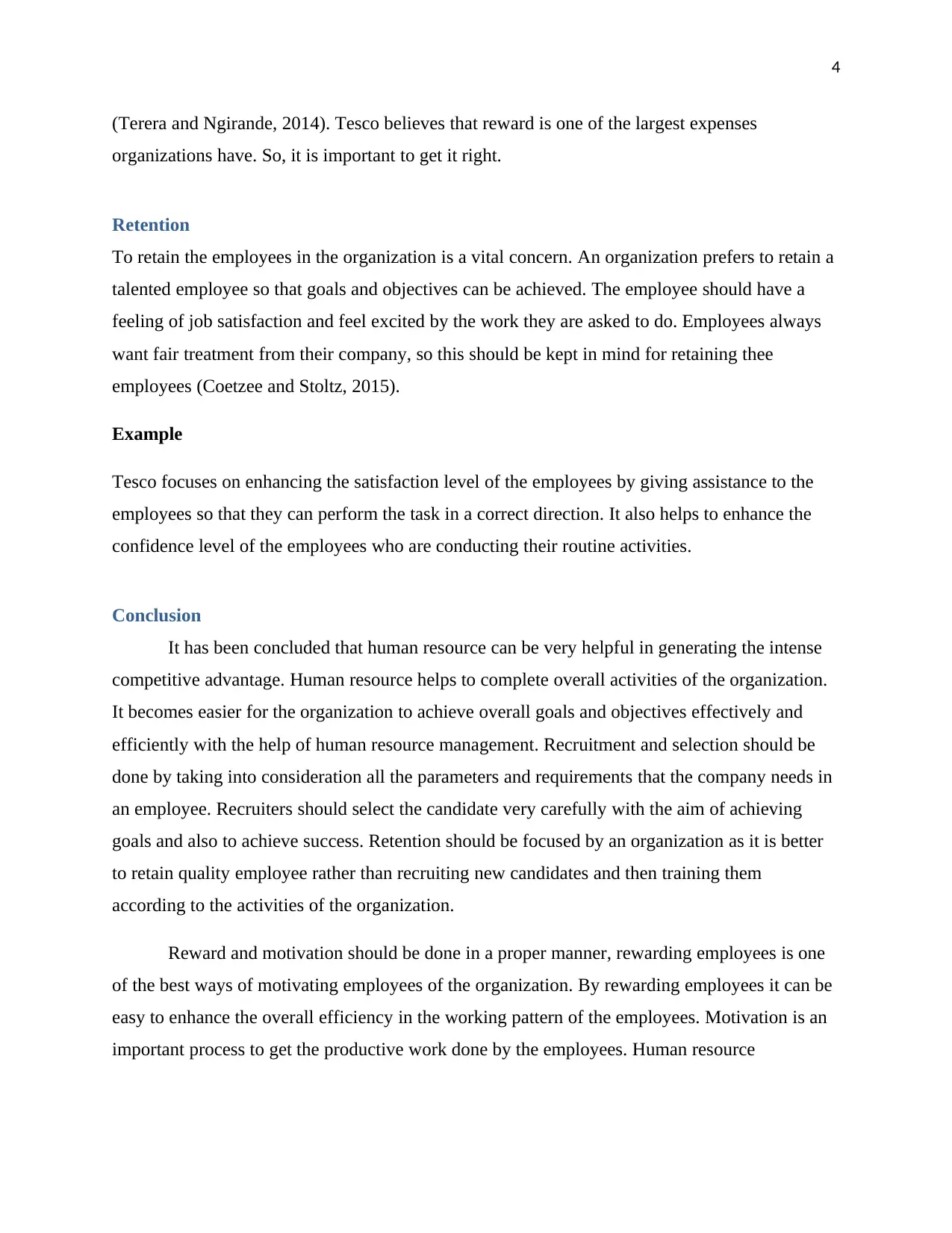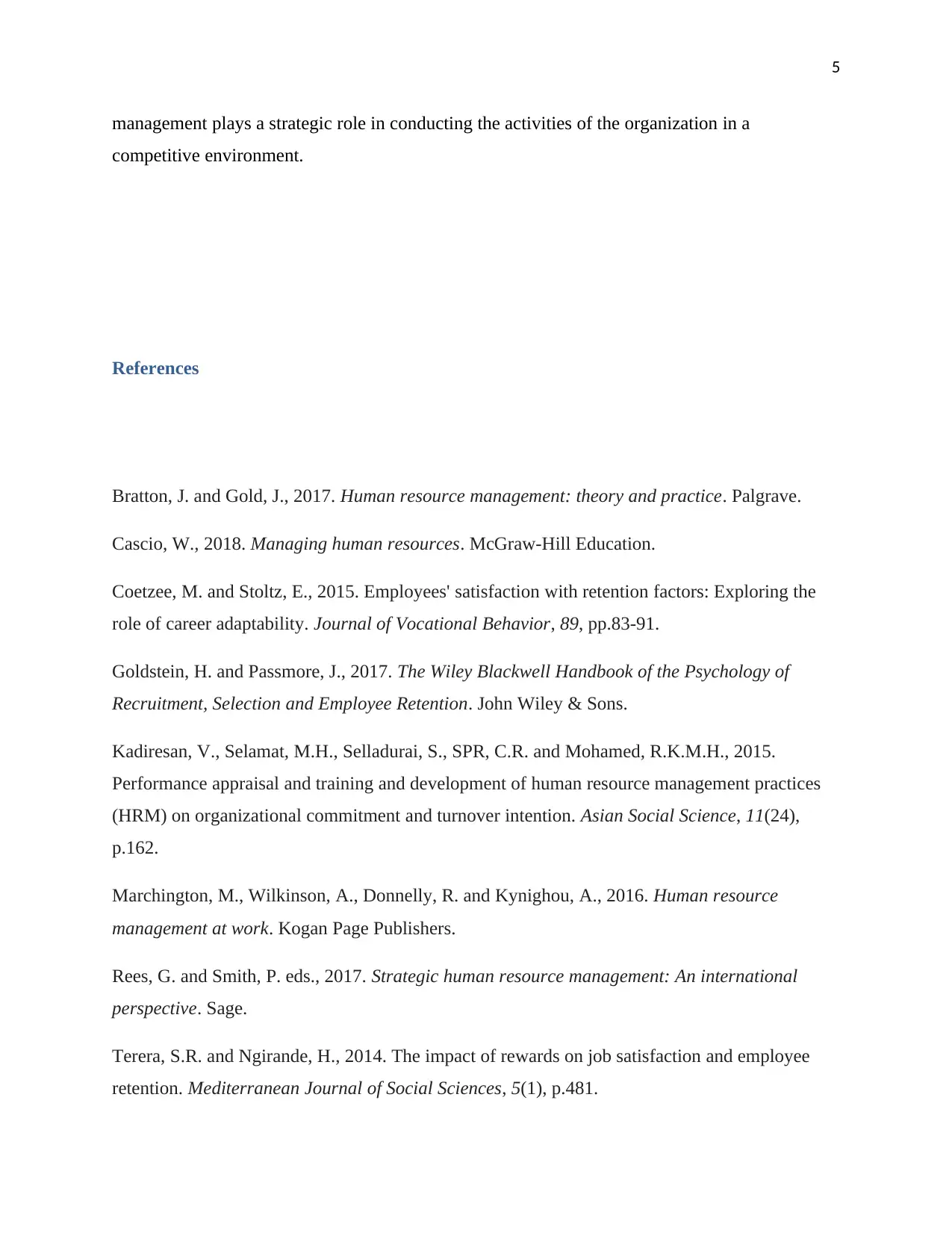Human Resource Management: Strategies for Competitive Advantage Report
VerifiedAdded on 2021/04/17
|6
|1404
|35
Report
AI Summary
This report provides a comprehensive overview of Human Resource Management (HRM) and its strategic importance in achieving organizational success. It covers key HRM activities such as recruitment and selection, emphasizing the importance of attracting and choosing suitable candidates. The report also discusses training and development programs designed to enhance employee skills and efficiency. Furthermore, it explores the role of reward structures and motivation in improving employee performance and satisfaction, as well as the significance of employee retention strategies. The report uses the Tesco case study to illustrate these concepts, highlighting how the company implements HRM practices to gain a competitive advantage. The conclusion emphasizes the strategic role of HRM in achieving overall organizational goals and objectives, stressing the importance of careful recruitment, effective training, appropriate rewards, and successful retention strategies.

Running Head: Human resource management
Human Resource Management
Human Resource Management
Paraphrase This Document
Need a fresh take? Get an instant paraphrase of this document with our AI Paraphraser

1
Table of Contents
Introduction.................................................................................................................................................1
Recruitment and selection...........................................................................................................................2
Training and development...........................................................................................................................3
Reward structure and motivation.................................................................................................................3
Retention.....................................................................................................................................................4
Conclusion...................................................................................................................................................4
References...................................................................................................................................................5
Introduction
Human resource management plays a strategic role in the success of an organization. The
success of an organization does not primarily depend on budget, products, and technologies but
Table of Contents
Introduction.................................................................................................................................................1
Recruitment and selection...........................................................................................................................2
Training and development...........................................................................................................................3
Reward structure and motivation.................................................................................................................3
Retention.....................................................................................................................................................4
Conclusion...................................................................................................................................................4
References...................................................................................................................................................5
Introduction
Human resource management plays a strategic role in the success of an organization. The
success of an organization does not primarily depend on budget, products, and technologies but

2
rely on employee's behavior, hard work, competency and attitude. Human resources are
considered as an important asset to the organization as it is helpful in generating intense
competitive advantage. The human resource of the organization helps to accomplish goals and
objectives in an effective manner (Cascio, 2018). Tesco established a customer-centered culture
that helped the organization to be successful in the market. Human resource management takes
into consideration the activities like training, motivating and takes care of health and safety
(Bratton and Gold, 2017). They also consider the factor of staffing and managing employee
benefits and compensation. So, in this paper, the discussion will be made on the human resource
management activities that help to be more competitive in the market.
Recruitment and selection
Recruitment and selection is the process that helps the organization to grow and to sustain
in the competitive environment. If capable employees are selected for conducting the activities of
the organization then it can help to enhance the overall profits. Recruitment includes attracting
the appropriate applicant to apply for the vacancies. The selection includes choosing the most
appropriate candidates from those who have applied for the particular vacancy. During
recruitment, an organization should always prepare a policy to set parameters according to the
vacancies (Goldstein and Passmore, 2017).
Example
Tesco takes into consideration human resource planning so that recruitment and selection
of appropriate candidates can be done. The company advertises the vacancies internally on its
intranet for two weeks. On the other hand for the external recruitment process, all the vacancies
are advertised by Tesco through its website i.e. www.tesco-careers.com and also through display
banners in stores. If in case some vacancies are hard to specialize in nature, Tesco adopts
external advertising through radio and television, website and offline media, advertising on
Google or in magazines. The requirements of the particular vacancies are elaborated so that the
applicants could match their talent according to the profile.
The company emphasizes on screening process at the time of conducting the selection
process. In the screening process the recruiter's focuses on the resume of the candidates. If they
are selected in the process of screening the candidates are called on the company outlet where the
rely on employee's behavior, hard work, competency and attitude. Human resources are
considered as an important asset to the organization as it is helpful in generating intense
competitive advantage. The human resource of the organization helps to accomplish goals and
objectives in an effective manner (Cascio, 2018). Tesco established a customer-centered culture
that helped the organization to be successful in the market. Human resource management takes
into consideration the activities like training, motivating and takes care of health and safety
(Bratton and Gold, 2017). They also consider the factor of staffing and managing employee
benefits and compensation. So, in this paper, the discussion will be made on the human resource
management activities that help to be more competitive in the market.
Recruitment and selection
Recruitment and selection is the process that helps the organization to grow and to sustain
in the competitive environment. If capable employees are selected for conducting the activities of
the organization then it can help to enhance the overall profits. Recruitment includes attracting
the appropriate applicant to apply for the vacancies. The selection includes choosing the most
appropriate candidates from those who have applied for the particular vacancy. During
recruitment, an organization should always prepare a policy to set parameters according to the
vacancies (Goldstein and Passmore, 2017).
Example
Tesco takes into consideration human resource planning so that recruitment and selection
of appropriate candidates can be done. The company advertises the vacancies internally on its
intranet for two weeks. On the other hand for the external recruitment process, all the vacancies
are advertised by Tesco through its website i.e. www.tesco-careers.com and also through display
banners in stores. If in case some vacancies are hard to specialize in nature, Tesco adopts
external advertising through radio and television, website and offline media, advertising on
Google or in magazines. The requirements of the particular vacancies are elaborated so that the
applicants could match their talent according to the profile.
The company emphasizes on screening process at the time of conducting the selection
process. In the screening process the recruiter's focuses on the resume of the candidates. If they
are selected in the process of screening the candidates are called on the company outlet where the
⊘ This is a preview!⊘
Do you want full access?
Subscribe today to unlock all pages.

Trusted by 1+ million students worldwide

3
capability is accessed by the managers. In this process, various tasks are provided to applicants
such as problem-solving exercise and situation based questions through which managers get help
in judging how the candidate would handle the situation during a job. Candidates who pass all
the stages are eligible for a final interview in which the managers make sure in the interview that
the applicant is selected according to the job profile (Rees and Smith, 2017).
Training and development
Training and development is also the activity conducted by human resource department. In this
training is given to the employees so that they can learn the activities of the organization in a
proper manner. Through training the skills of the employees are developed so that they can
conduct the activities with efficiency.
Example
In Tesco, human resource team gives emphasis on training and developing the skills of the
employees. They are given on the job training that helps to evaluate their capability to conduct
the activities with proper efficiency.
Reward structure and motivation
Reward structure and motivation is the process of assessing the performance to analyze
the need for training and development. Reward system refers to all financial, non-financial and
intellectual payments that are provided to the employees according to the overall performance.
The organization takes into consideration reward structure so that the employees of the
organization feel motivated towards the assigned activities (Kadiresan et al., 2015). Every
organization expects hard work from their employees and if employees are fulfilling the
expectations then they expect something in exchange (Marchington et al., 2016).
Example
Tesco gives importance to the employee's performance appraisal system. Tesco has
reward objectives which help them to keep their employees happy and motivated. They offer
great rewards to their employees such as privilege cards, long service award and high incentives
capability is accessed by the managers. In this process, various tasks are provided to applicants
such as problem-solving exercise and situation based questions through which managers get help
in judging how the candidate would handle the situation during a job. Candidates who pass all
the stages are eligible for a final interview in which the managers make sure in the interview that
the applicant is selected according to the job profile (Rees and Smith, 2017).
Training and development
Training and development is also the activity conducted by human resource department. In this
training is given to the employees so that they can learn the activities of the organization in a
proper manner. Through training the skills of the employees are developed so that they can
conduct the activities with efficiency.
Example
In Tesco, human resource team gives emphasis on training and developing the skills of the
employees. They are given on the job training that helps to evaluate their capability to conduct
the activities with proper efficiency.
Reward structure and motivation
Reward structure and motivation is the process of assessing the performance to analyze
the need for training and development. Reward system refers to all financial, non-financial and
intellectual payments that are provided to the employees according to the overall performance.
The organization takes into consideration reward structure so that the employees of the
organization feel motivated towards the assigned activities (Kadiresan et al., 2015). Every
organization expects hard work from their employees and if employees are fulfilling the
expectations then they expect something in exchange (Marchington et al., 2016).
Example
Tesco gives importance to the employee's performance appraisal system. Tesco has
reward objectives which help them to keep their employees happy and motivated. They offer
great rewards to their employees such as privilege cards, long service award and high incentives
Paraphrase This Document
Need a fresh take? Get an instant paraphrase of this document with our AI Paraphraser

4
(Terera and Ngirande, 2014). Tesco believes that reward is one of the largest expenses
organizations have. So, it is important to get it right.
Retention
To retain the employees in the organization is a vital concern. An organization prefers to retain a
talented employee so that goals and objectives can be achieved. The employee should have a
feeling of job satisfaction and feel excited by the work they are asked to do. Employees always
want fair treatment from their company, so this should be kept in mind for retaining thee
employees (Coetzee and Stoltz, 2015).
Example
Tesco focuses on enhancing the satisfaction level of the employees by giving assistance to the
employees so that they can perform the task in a correct direction. It also helps to enhance the
confidence level of the employees who are conducting their routine activities.
Conclusion
It has been concluded that human resource can be very helpful in generating the intense
competitive advantage. Human resource helps to complete overall activities of the organization.
It becomes easier for the organization to achieve overall goals and objectives effectively and
efficiently with the help of human resource management. Recruitment and selection should be
done by taking into consideration all the parameters and requirements that the company needs in
an employee. Recruiters should select the candidate very carefully with the aim of achieving
goals and also to achieve success. Retention should be focused by an organization as it is better
to retain quality employee rather than recruiting new candidates and then training them
according to the activities of the organization.
Reward and motivation should be done in a proper manner, rewarding employees is one
of the best ways of motivating employees of the organization. By rewarding employees it can be
easy to enhance the overall efficiency in the working pattern of the employees. Motivation is an
important process to get the productive work done by the employees. Human resource
(Terera and Ngirande, 2014). Tesco believes that reward is one of the largest expenses
organizations have. So, it is important to get it right.
Retention
To retain the employees in the organization is a vital concern. An organization prefers to retain a
talented employee so that goals and objectives can be achieved. The employee should have a
feeling of job satisfaction and feel excited by the work they are asked to do. Employees always
want fair treatment from their company, so this should be kept in mind for retaining thee
employees (Coetzee and Stoltz, 2015).
Example
Tesco focuses on enhancing the satisfaction level of the employees by giving assistance to the
employees so that they can perform the task in a correct direction. It also helps to enhance the
confidence level of the employees who are conducting their routine activities.
Conclusion
It has been concluded that human resource can be very helpful in generating the intense
competitive advantage. Human resource helps to complete overall activities of the organization.
It becomes easier for the organization to achieve overall goals and objectives effectively and
efficiently with the help of human resource management. Recruitment and selection should be
done by taking into consideration all the parameters and requirements that the company needs in
an employee. Recruiters should select the candidate very carefully with the aim of achieving
goals and also to achieve success. Retention should be focused by an organization as it is better
to retain quality employee rather than recruiting new candidates and then training them
according to the activities of the organization.
Reward and motivation should be done in a proper manner, rewarding employees is one
of the best ways of motivating employees of the organization. By rewarding employees it can be
easy to enhance the overall efficiency in the working pattern of the employees. Motivation is an
important process to get the productive work done by the employees. Human resource

5
management plays a strategic role in conducting the activities of the organization in a
competitive environment.
References
Bratton, J. and Gold, J., 2017. Human resource management: theory and practice. Palgrave.
Cascio, W., 2018. Managing human resources. McGraw-Hill Education.
Coetzee, M. and Stoltz, E., 2015. Employees' satisfaction with retention factors: Exploring the
role of career adaptability. Journal of Vocational Behavior, 89, pp.83-91.
Goldstein, H. and Passmore, J., 2017. The Wiley Blackwell Handbook of the Psychology of
Recruitment, Selection and Employee Retention. John Wiley & Sons.
Kadiresan, V., Selamat, M.H., Selladurai, S., SPR, C.R. and Mohamed, R.K.M.H., 2015.
Performance appraisal and training and development of human resource management practices
(HRM) on organizational commitment and turnover intention. Asian Social Science, 11(24),
p.162.
Marchington, M., Wilkinson, A., Donnelly, R. and Kynighou, A., 2016. Human resource
management at work. Kogan Page Publishers.
Rees, G. and Smith, P. eds., 2017. Strategic human resource management: An international
perspective. Sage.
Terera, S.R. and Ngirande, H., 2014. The impact of rewards on job satisfaction and employee
retention. Mediterranean Journal of Social Sciences, 5(1), p.481.
management plays a strategic role in conducting the activities of the organization in a
competitive environment.
References
Bratton, J. and Gold, J., 2017. Human resource management: theory and practice. Palgrave.
Cascio, W., 2018. Managing human resources. McGraw-Hill Education.
Coetzee, M. and Stoltz, E., 2015. Employees' satisfaction with retention factors: Exploring the
role of career adaptability. Journal of Vocational Behavior, 89, pp.83-91.
Goldstein, H. and Passmore, J., 2017. The Wiley Blackwell Handbook of the Psychology of
Recruitment, Selection and Employee Retention. John Wiley & Sons.
Kadiresan, V., Selamat, M.H., Selladurai, S., SPR, C.R. and Mohamed, R.K.M.H., 2015.
Performance appraisal and training and development of human resource management practices
(HRM) on organizational commitment and turnover intention. Asian Social Science, 11(24),
p.162.
Marchington, M., Wilkinson, A., Donnelly, R. and Kynighou, A., 2016. Human resource
management at work. Kogan Page Publishers.
Rees, G. and Smith, P. eds., 2017. Strategic human resource management: An international
perspective. Sage.
Terera, S.R. and Ngirande, H., 2014. The impact of rewards on job satisfaction and employee
retention. Mediterranean Journal of Social Sciences, 5(1), p.481.
⊘ This is a preview!⊘
Do you want full access?
Subscribe today to unlock all pages.

Trusted by 1+ million students worldwide
1 out of 6
Related Documents
Your All-in-One AI-Powered Toolkit for Academic Success.
+13062052269
info@desklib.com
Available 24*7 on WhatsApp / Email
![[object Object]](/_next/static/media/star-bottom.7253800d.svg)
Unlock your academic potential
Copyright © 2020–2025 A2Z Services. All Rights Reserved. Developed and managed by ZUCOL.





